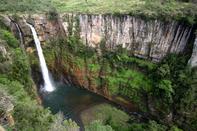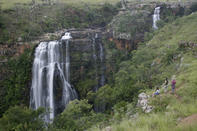Mac Mac Falls Near Sabie
Mac Mac Falls in Mpumalanga, on the Mac Mac River, splits into two and the columns of water plummet side by side for 65 metres into a pool in the gorge below. Just one of many magical falls in the area. One of the first strikes producing serious gold was made along a stream near the edge of the Escarpment, between Sabie and Pilgrim's Rest.

When President Burger visited the diggings in the 1880s, he noted there were many Scots and joked it should be called Mac Mac. Mac Mac was on the route between Sabie, Graskop and Pilgrim's Rest, and a Jock plaque can be seen near the falls on the side of the road (going towards Pilgrim's Rest, a little way past the falls on the left).
At 65 m these falls - and in this case the plural is appropriate, as there are two falls -- are not the most impressive of the many waterfalls in the Mpumalanga Escarpment area, but they are the best known and most easily accessible. Also, they pose a photographic challenge, because they plunge into a narrow ravine that is usually either completely or partially in hard shadow. Once upon a time, there was only one waterfall here.
But it was not a geological process that caused the river to split in two over the very hard Black Reef Quartzite ledge. It was men; men with dynamite, determined to mine the gold-bearing rock by diverting the river, who did the divine act a little more than a century ago.
Plenty of Waterfalls

Visit Lisbon’s Double Stream for the best view of Mpumalanga's falls, walk along a footpath to the base of the falls, which is a double stream 92 metres over a semi-circular rock face.
The mighty Berlin Falls are the most spectacular in Mpumalanga, which has plenty of waterfalls to boast. The water cascades 80 metres over a cliff and into a deep green pool below. You can’t get too close to the falls, but an observation platform offers great views.